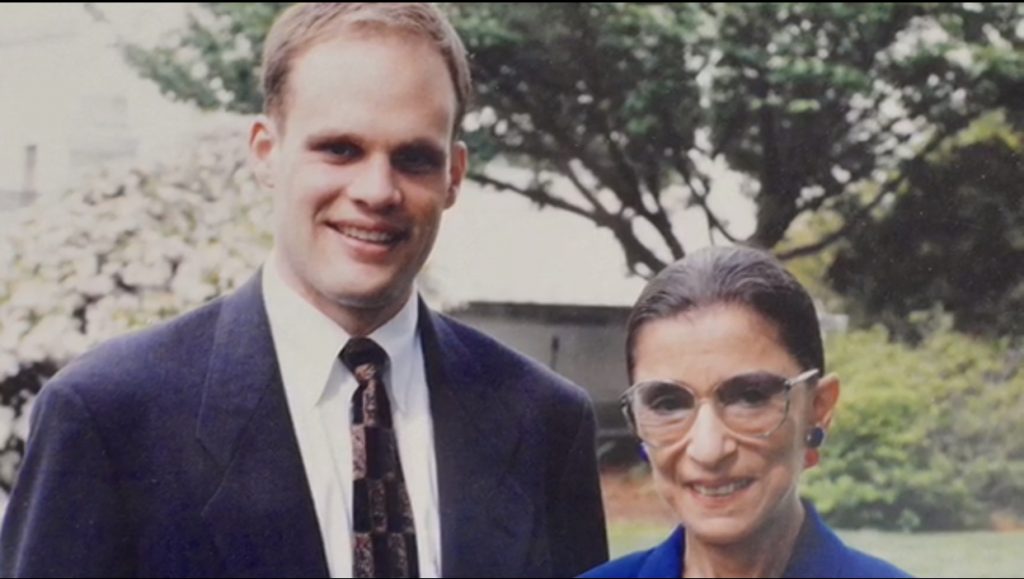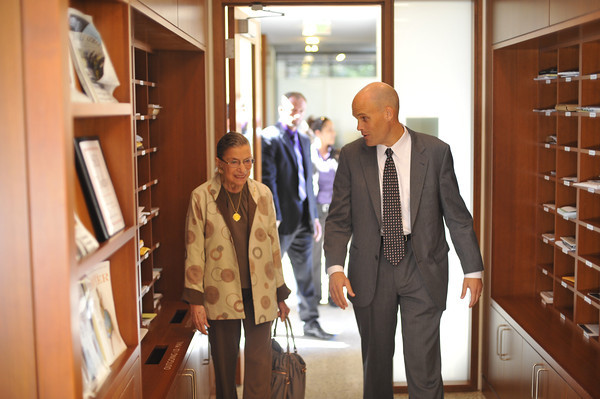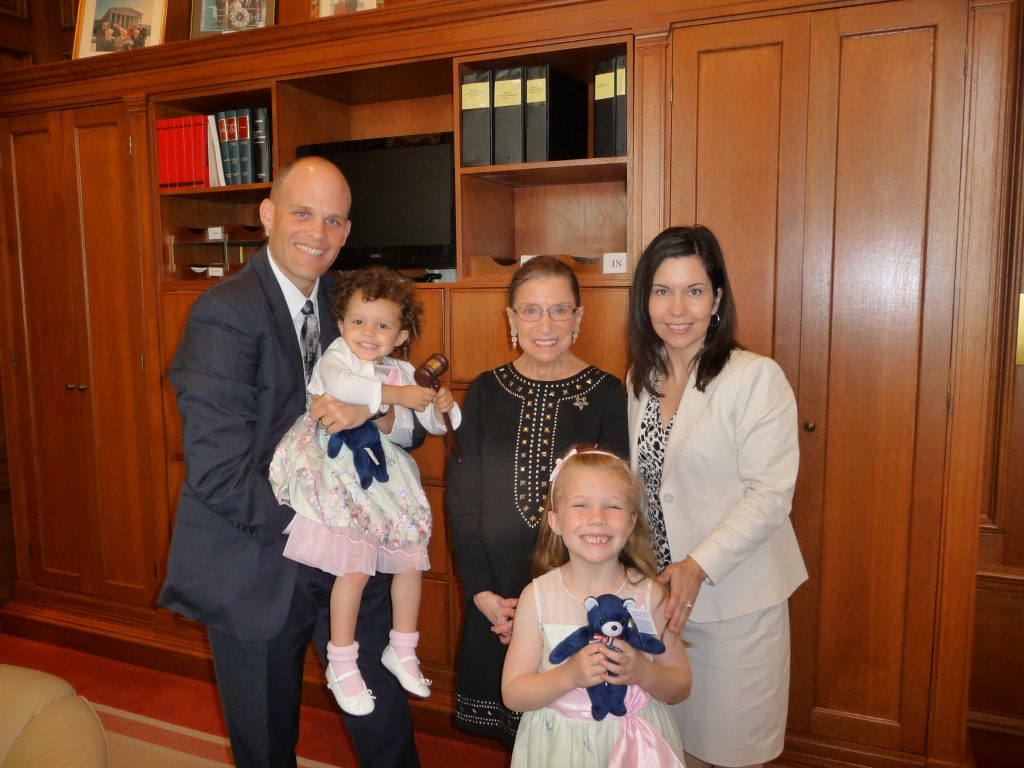“The Justice has died.”
“What?!?!?” asked my wife as she ran in the room.
“The Justice has died,” I repeated as I pointed to our television.
My wife burst into tears. My daughters were devastated. A woman who meant so much to our family had left us.
It was Friday, September 18, 2020. We learned of her passing like most Americans. We knew that she was struggling physically—my family recorded a video for her in mid-August 2020, wishing her well and looking forward to seeing her in 2021, once the pandemic had abated and she could again have visitors. But we did not know that we would never see her again.
On a personal level, this was very, very hard. Not only was the Justice the biggest professional influence on me, but she had been there for the key events of my adulthood—offering advice on how to approach my future father-in-law, speaking to my daughter’s eighth grade class on their trip to the East Coast. In one way or another, she impacted everything I have done since 1997. I am extremely fortunate to have had that relationship with her, and I will miss visiting with her in chambers and on trips, sending her family updates and boxes of See’s Candies (which she never ate but shared with the staff).
But, as the incredible outpouring of grief and support for the Justice from people who never met her demonstrated, she is not “gone” by any stretch. Like many of our nation’s heroes, she will be with us for as long as our republic lasts. And because I was lucky enough to spend time with her in a variety of settings—as a law clerk, at public events, in personal family settings, and later as a judge myself—I wanted to share some experiences and lessons that I learned along the way.
I. Before the “Notorious RBG”
When people learn about my background, they invariably say, “It must have been incredible working for the Notorious RBG. She’s amazing!” I usually smile and nod in agreement. But, for the first time, I’ll answer that question honestly.
I did not work for the Notorious RBG.
So why, you may ask, did the Columbia Law Review include this essay in its tribute to the Justice?
Because I clerked for Justice Ginsburg more than 15 years before “Notorious RBG” was coined. The Notorious B.I.G. was murdered a few months before I started at the Court. Internet was dial-up and no such thing as social media existed—online in chambers meant checking Westlaw or Lexis, and there was no way to check personal email until we went home (it made participating in a fantasy basketball league extremely difficult). And while there were inklings that pop culture would champion her (such as the late 1990s VH1 “Pop-Up Video” of the song “Stupid Girl” featuring the Justice as a “smart girl”), the Notorious RBG (and the attendant whirlwind of attention) did not appear until many years later.
So what was the pre-Notorious RBG like? Many have written and spoken about her personal relationship with Justice Scalia, and rightfully so. And while that personal relationship may have influenced her legal thinking in her first couple years on the Court, by 1997, I didn’t see any permanent jurisprudential spell cast over her: Any sway that Justice Scalia had in Heck v. Humphrey was gone just a few years later.
1
In Heck, the Court (Justice Scalia, joined by Chief Justice Rehnquist, Justice Thomas, Justice Kennedy, and Justice Ginsburg) held that a plaintiff cannot use 42 U.S.C. § 1983 to seek compensation for a wrongful conviction unless a court had previously invalidated the conviction through the direct appeal or habeas corpus process. Heck v. Humphrey, 512 U.S. 477, 486–87 (1994). Justice Ginsburg (in her first year on the Court) did not join the four-member concurrence of Justice Souter. Id. at 491. A few years later, she reflected on her vote in Heck and stated that she had “come to agree with Justice Souter’s reasoning” and that “[w]isdom too often never comes, and so one ought not to reject it merely because it comes late.” Spencer v. Kemna, 523 U.S. 1, 21–22 (1998) (Ginsburg, J., concurring) (internal quotation marks omitted) (quoting Henslee v. Union Planters Nat. Bank & Tr. Co., 335 U.S. 595, 600 (1949) (Frankfurter, J., dissenting)).
With her academic background focusing on civil procedure and civil rights (and her time on the D.C. Circuit with no state court criminal docket), the Justice likely had little experience dealing with habeas corpus and collateral attacks on criminal convictions (including death penalty litigation) when she joined the Court. By 1997, that had changed.
In those early years on the Court, I found that her working relationships with Justice O’Connor and Chief Justice Rehnquist were the most significant. The Justice has spoken in depth about her respect for Justice O’Connor, especially when dealing with the challenges and agonies of cancer. 2 See, e.g., Justice Ruth Bader Ginsburg, A Tribute to Justice Sandra Day O’Connor, 119 Harv. L. Rev. 1239, 1240–41 (2006) (describing how Justice O’Connor did not miss a sitting on the Court during the Term despite receiving rigorous cancer treatment). And her admiration extended to cases. I recall one matter where another chambers had circulated an opinion that was off the mark. When I outlined my concerns, the Justice agreed but wanted to know if Justice O’Connor was on board. It turned out that they were on the same page; Justice O’Connor circulated a memo that Justice Ginsburg immediately supported, and the final version of the opinion followed suit.
Her fondness for the Chief also ran deep. His intellect was towering—I recall once where he corrected a lawyer’s characterization of an old case from the bench based solely on his incredible memory. I thought he was the smartest person in the building, and I know she thought very highly of him as well. Everyone at the Court—from the cafeteria to the Conference Room—deeply respected him. As she reflected shortly after his death: “[O]f all the bosses I have had as lawyer, law teacher, and judge, Chief Justice Rehnquist was hands down the fairest and most efficient. Presiding over six prime dons and two prima donnas, he kept us all in line and on time.” 3 See Justice Ruth Bader Ginsburg, Tribute to Chief Justice William Hubbs Rehnquist, 74 Geo. Wash. L. Rev. 869, 869 (2006).
One of her big assignments my year was Baker v. General Motors Corp., 4 522 U.S. 222, 240–41 (1998) (holding that an injunction barring a former employee from testifying as witness did not extend beyond the controversy between the employee and manufacturer to control proceedings elsewhere, and thus, the employee could testify in other proceedings brought against the manufacturer without offense to the Full Faith and Credit Clause). a somewhat obscure but important civil procedure case. While Justices accept whatever opinions the Chief (or the most senior majority Justice) assigns, they prefer some more than others. Baker was the case that the Justice really wanted.
Back then, the Justice’s chambers were on the second floor, across the hall from the kitchen and dining room. Unlike the other chambers, her entire staff was in the same workplace. The door leading into my office had a “Justice Ginsburg” sign on the outside, even though it wasn’t the main entrance to chambers, and no one used the door except for me and another clerk. So you can imagine my surprise when the Chief opened the door and asked to meet with Justice Ginsburg. I jumped up from my desk (I’m not sure I’ve ever moved so fast), and escorted him to the waiting area in chambers. The Justice immediately greeted him, and she later told us with a big grin in our team meeting that the Chief had assigned her Baker.
I cherish these interactions with the Justice more than anything else. Not only did we receive her report of the Friday conference (where the Justices discuss the cases in private and receive opinion assignments), but we would get treats, and sometimes, tricks. For example, one time the Justice asked us who she saw in the elevator at her Watergate apartment earlier that day. I was expecting some politician or opera singer. “Monica Lewinsky!” the Justice announced with a big smile. She added that Ms. Lewinsky seemed very charming.
II. What About the “Notorious RBG”?
So I didn’t clerk for the Notorious RBG. But I have observed this phenomenon both up close and from afar. What do I think about it?
Honestly, I’ve had mixed opinions about this movement. I visited with the Justice in recent years in several cities, and it’s the closest I’ve been to an international celebrity. Sometimes the reactions were heartwarming, such as the two young women who saw her exit a restaurant in San Francisco and, without saying a word, asked each other with their faces, “Is that her? I think that’s her? Oh my God, that’s her!!!” Other times, people’s behavior was obnoxious and borderline scary—trying to grab her for a selfie or interrupting her meal to shove something in her face to autograph. She required security when she travelled, which was very different from my clerkship experience with her, where we could walk to an opera or stand in front of the Court without any concerns.
And at times, I thought the character “Notorious RBG” was more “caricature” than reality. The “I Dissent” vision of Justice Ginsburg suggests that she was outcome driven, nobly going down swinging against a conservative majority. Memes are necessarily two-dimensional, and this meme made it easier for some to dismiss her thoughtful opinions as the words of the Court’s leading “liberal.”
Whenever asked about the lessons I learned from the Justice, I highlight a number of things, including that I never met anyone who worked so hard to get the right answer. While I didn’t always agree with her about what the answer should be (more on that later), I never thought that politics or a “liberal agenda” were driving her decisionmaking. Rather, it was hard work and unending analysis that led to the proper result. I imagine that the influence of one of her mentors (and mine coincidentally), Professor Gerald Gunther, greatly impacted her approach to complex questions of law. The “Notorious RBG” meme, in my view, threatens to undermine this core value of hers.
So that’s the “back-in-my-day” view of the Notorious RBG. It’s clear that she adored the moniker and movement—her excitement when she spoke to huge crowds at law schools was genuine and heartwarming. For so long, her husband Marty was her partner, and once he passed away, the meme really energized her. She loved working and speaking with young people, and this identity gave her new audiences to connect with. And the bigger her legacy became, the longer that legacy (and its message) would last.
And what message did she want to convey? How would I characterize the jurisprudence of the Justice?
Scholars will have the final—and probably best—take on the Justice’s legal theory, but here is mine: The Justice loved the United States. She thought it the greatest country in the world—“the melting pot”—and that everyone should have the same opportunities to succeed, regardless of race, religion, or gender. She often remarked how her mother was a bookkeeper in Brooklyn, and one generation later, she was at the Supreme Court. Much of her jurisprudence, from her work for the ACLU to her opinions in United States v. Virginia 5 508 U.S. 946 (1993). and Shelby County, 6 Shelby County v. Holder, 570 U.S. 529, 559–94 (2013) (Ginsburg, J., dissenting). fits into this narrative—giving everyone the same opportunities to live the American Dream. 7 It also helps explain her reluctance at times to accept Native American tribal sovereignty claims, as recognizing separate nations within the United States can clash with the “melting pot” philosophy. For a review of Justice Ginsburg’s early Indian law cases and the gradual shift in her thinking, see generally Carole Goldberg, Finding the Way to Indian Country: Justice Ruth Bader Ginsburg’s Decisions in Indian Law Cases, 70 Ohio St. L.J. 1003 (2009).
III. Life Lessons
What are the life lessons she imparted to me? I’ve boxed for much of my adult life, so I know guys who are really, really tough. Yet I’ve never met anyone as tough as the Justice. Despite all of the incredible obstacles she faced—her mother dying while she was in high school, caring for Marty when he was sick while raising a baby and going to law school, struggling to find work after graduation because she was a Jewish woman with a young child, and her own significant health problems at the Court—I never heard her complain or make excuses. She would just put her head down and get the job done to the highest standards. She never took shortcuts or the easy way out. In times like these, that is a very important lesson to live by.
But I didn’t fully appreciate another important (and personal) lesson until almost twenty years later. A law clerk’s primary role is to support the Justice in any way possible, and sometimes that means challenging the Justice’s views on a case. But there comes a time when the law clerk needs to stop objecting and start writing, consistent with the Justice’s views.
During my year, there was one case in which I strongly disagreed with the Justice. I continually voiced my concerns, until one morning when the Justice made clear that she’d had enough: “That’s fine, John.” Pause. “But I’m the Justice.” Pause. “And you’re not.” 8 Almost one hundred law clerks and hundreds of opinions have passed through her chambers since that exchange. Yet incredibly, when I reenacted this conversation before a group of law students and the Justice more than twenty years later, the Justice not only remembered it, but even recalled the case and who wrote the majority.
For many years, I remembered this as the Justice telling me who was boss and who wasn’t, which is an important lesson for anyone who has a boss. But once I became a judge, I better understood what the Justice was telling me—that it wasn’t about me. She was saying that at the end of the day, she was the one with the presidential commission, not me. So she was the one who needed to feel comfortable with the decision. And if she didn’t feel that the majority view was correct, she had the obligation to say so. Now that I have taken the judicial oath, I better appreciate what she was really trying to say. Collegiality is very important, but sometimes you have to disagree.
Marty Ginsburg often said that America’s symbol isn’t the bald eagle, but the pendulum. And the national pendulum has swung wildly over the past few years. The Justice’s unwavering lessons of fairness, hard work, and intellectual courage are exactly what our nation needs in these turbulent times, notorious or otherwise.



